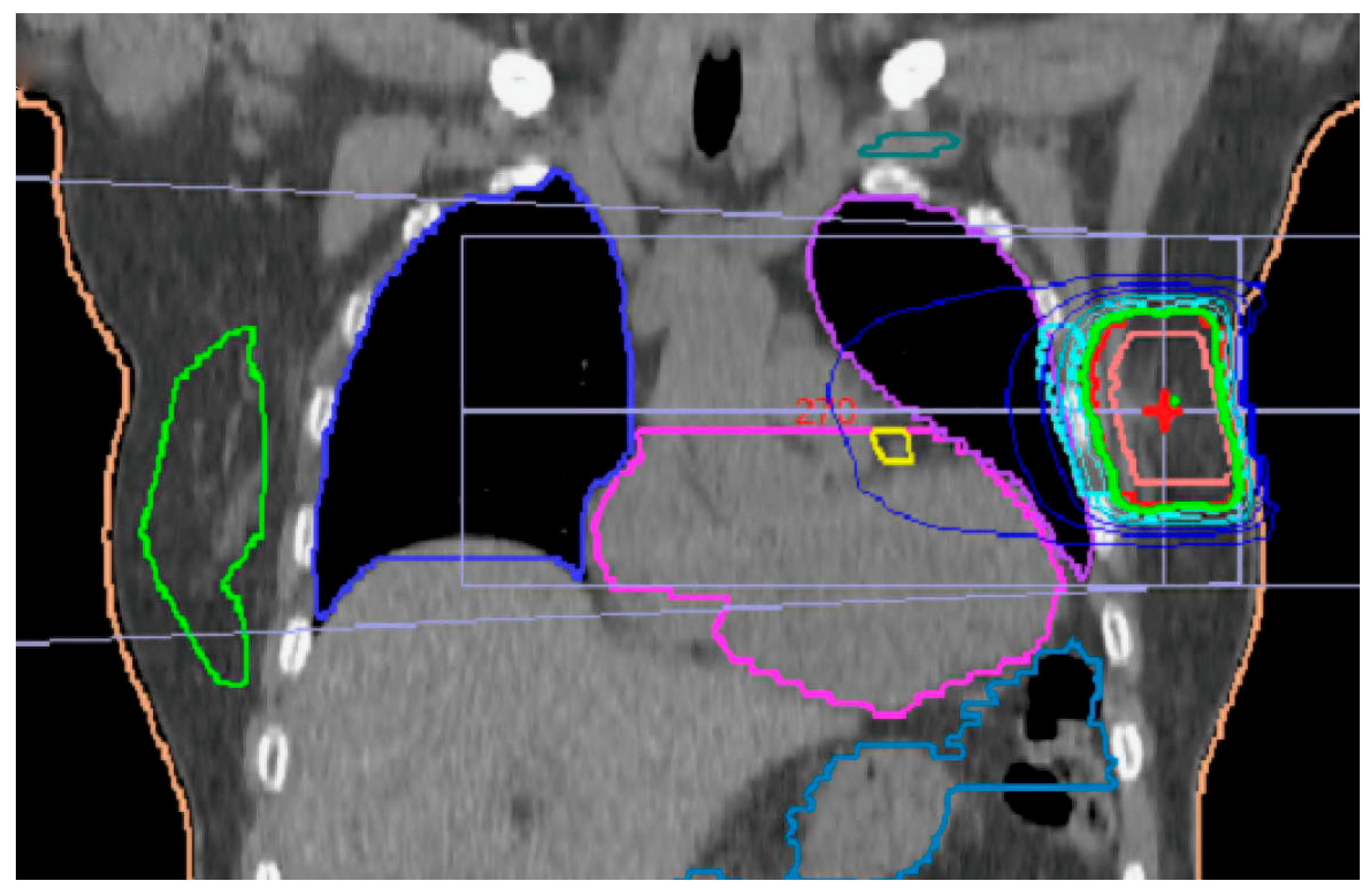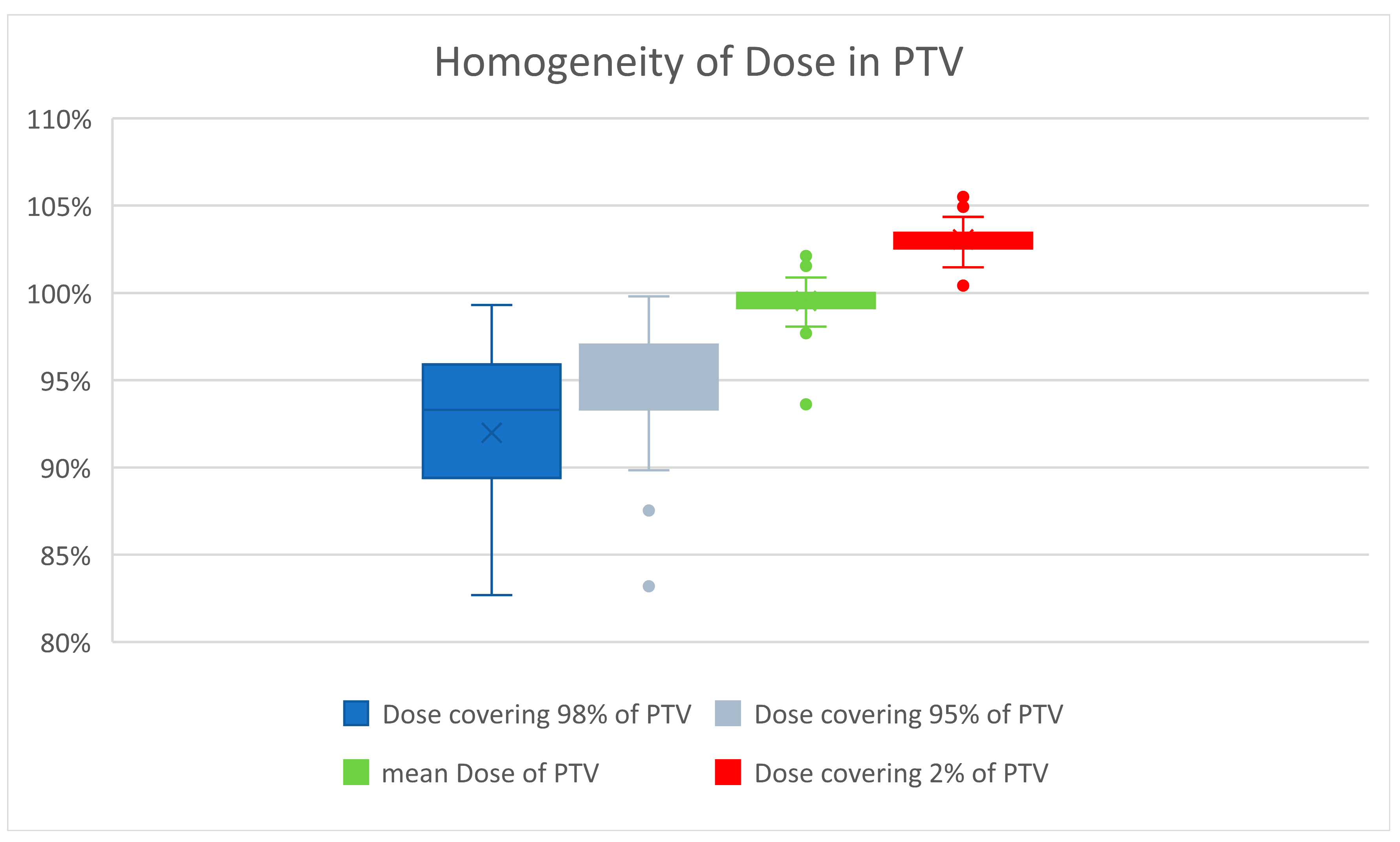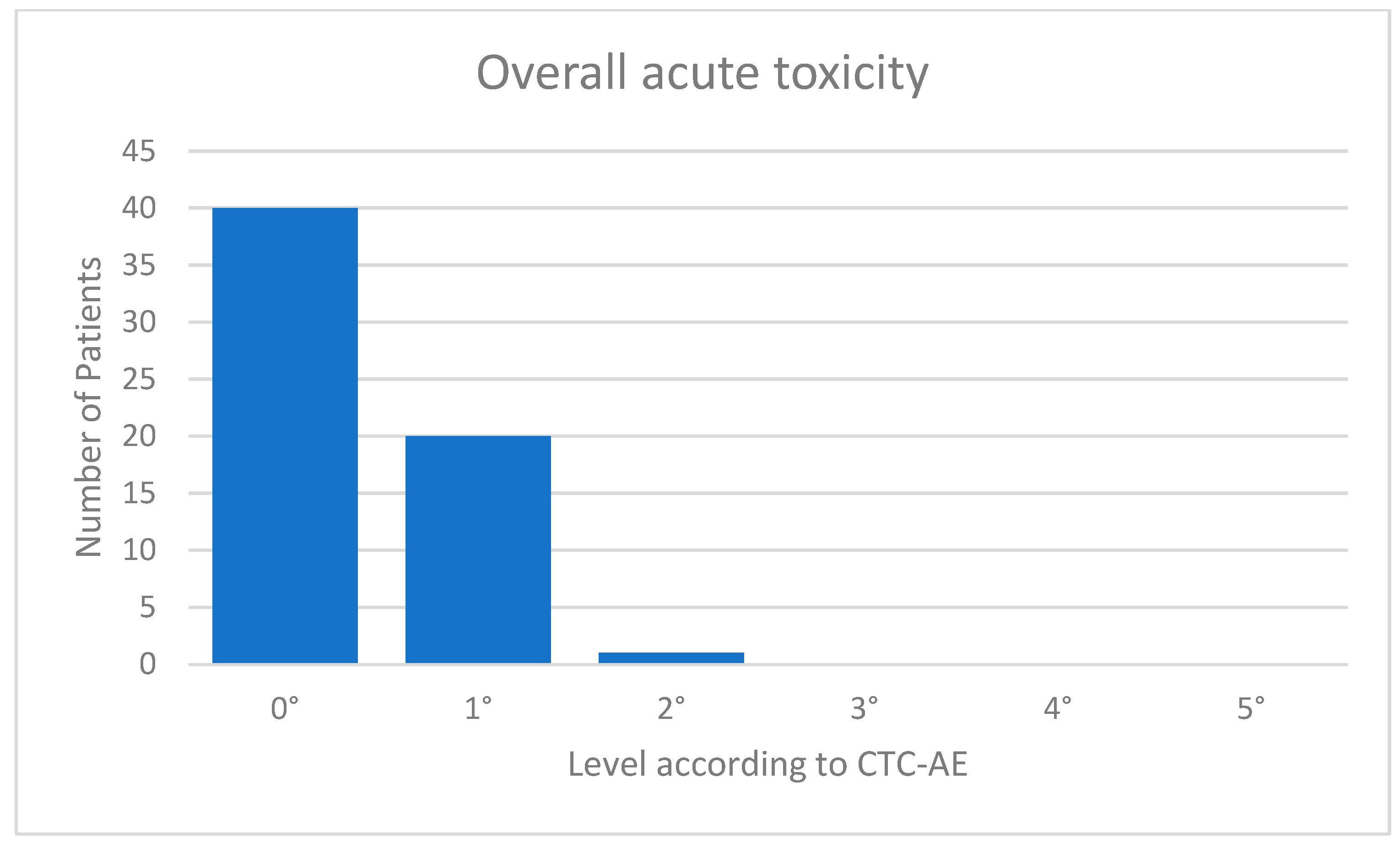Linac-Based Ultrahypofractionated Partial Breast Irradiation (APBI) in Low-Risk Breast Cancer: First Results of a Monoinstitutional Observational Analysis
Abstract
Simple Summary
Abstract
1. Introduction
2. Materials and Methods
3. Results
3.1. Quantitative Dose-Volume Analysis of PTV
3.2. Organs at Risk
3.3. Analysis of Acute Clinical Toxicity
4. Discussion
5. Conclusions
Supplementary Materials
Author Contributions
Funding
Institutional Review Board Statement
Informed Consent Statement
Data Availability Statement
Conflicts of Interest
References
- Yarnold, J.; Ashton, A.; Bliss, J.; Homewood, J.; Harper, C.; Hanson, J.; Haviland, J.; Bentzen, S.; Owen, R. Fractionation sensitivity and dose response of late adverse effects in the breast after radiotherapy for early breast cancer: Long-term results of a randomised trial. Radiother. Oncol. 2005, 75, 9–17. [Google Scholar] [CrossRef]
- Shaitelman, S.F.; Schlembach, P.J.; Arzu, I.; Ballo, M.; Bloom, E.S.; Buchholz, D.; Chronowski, G.M.; Dvorak, T.; Grade, E.; Hoffman, K.E.; et al. Acute and short-term toxic effects of conventionally fractionated vs hypofractionated whole-breast irradiation: A randomized clinical trial. JAMA Oncol. 2015, 1, 931–941. [Google Scholar] [CrossRef]
- Haviland, J.S.; Owen, J.R.; Dewar, J.A.; Agrawal, R.K.; Barrett, J.; Barrett-Lee, P.J.; Dobbs, H.J.; Hopwood, P.; Lawton, P.A.; Magee, B.J.; et al. The UK standardisation of breast radiotherapy (START) trials of radiotherapy hypofractionation for treatment of early breast cancer: 10-year follow-up results of two randomised controlled trials. Lancet Oncol. 2013, 14, 1086–1094. [Google Scholar] [CrossRef] [PubMed]
- Whelan, T.J.; Julian, J.A.; Berrang, T.S.; Kim, D.H.; Germain, I.; Nichol, A.M.; Akra, M.; Lavertu, S.; Germain, F.; Fyles, A.; et al. External beam accelerated partial breast irradiation versus whole breast irradiation after breast conserving surgery in women with ductal carcinoma in situ and node-negative breast cancer (RAPID): A randomised controlled trial. Lancet 2019, 394, 2165–2172. [Google Scholar] [CrossRef]
- Polgár, C.; Van Limbergen, E.; Pötter, R.; Kovács, G.; Polo, A.; Lyczek, J.; Hildebrandt, G.; Niehoff, P.; Guinot, J.L.; Guedea, F.; et al. Patient selection for accelerated partial-breast irradiation (APBI) after breast-conserving surgery: Recommendations of the groupe Européen de curiethérapie-European society for therapeutic radiology and oncology (GEC-ESTRO) breast cancer working group based on clinical evidence (2009). Radiother. Oncol. 2010, 94, 264–273. [Google Scholar] [CrossRef]
- Veronesi, U.; Orecchia, R.; Maisonneuve, P.; Viale, G.; Rotmensz, N.; Sangalli, C.; Luini, A.; Veronesi, P.; Galimberti, V.; Zurrida, S.; et al. Intraoperative radiotherapy versus external radiotherapy for early breast cancer (ELIOT): A randomised controlled equivalence trial. Lancet Oncol. 2013, 14, 1269–1277. [Google Scholar] [CrossRef] [PubMed]
- Vaidya, J.S.; Wenz, F.; Bulsara, M.; Tobias, J.S.; Joseph, D.J.; Keshtgar, M.; Flyger, H.L.; Massarut, S.; Alvarado, M.; Saunders, C.; et al. Risk-adapted targeted intraoperative radiotherapy versus whole-breast radiotherapy for breast cancer: 5-year results for local control and overall survival from the TARGIT-A randomised trial. Lancet 2014, 383, 603–613. [Google Scholar] [CrossRef] [PubMed]
- Strnad, V.; Ott, O.J.; Hildebrandt, G.; Kauer-Dorner, D.; Knauerhase, H.; Major, T.; Lyczek, J.; Guinot, J.L.; Dunst, J.; Miguelez, C.G.; et al. 5-year results of accelerated partial breast irradiation using sole interstitial multicatheter brachytherapy versus whole-breast irradiation with boost after breast-conserving surgery for low-risk invasive and in-situ carcinoma of the female breast: A randomised, phase 3, non-inferiority trial. Lancet 2016, 387, 229–238. [Google Scholar] [CrossRef]
- Livi, L.; Meattini, I.; Marrazzo, L.; Simontacchi, G.; Pallotta, S.; Saieva, C.; Paiar, F.; Scotti, V.; De Luca Cardillo, C.; Bastiani, P.; et al. Accelerated partial breast irradiation using intensity-modulated radiotherapy versus whole breast irradiation: 5-year survival analysis of a phase 3 randomised controlled trial. Eur. J. Cancer 2015, 51, 451–463. [Google Scholar] [CrossRef]
- Meattini, I.; Marrazzo, L.; Saieva, C.; Desideri, I.; Scotti, V.; Simontacchi, G.; Bonomo, P.; Greto, D.; Mangoni, M.; Scoccianti, S.; et al. Accelerated partial-breast irradiation compared with whole-breast irradiation for early breast cancer: Long-term results of the randomized phase III APBI-IMRT-florence trial. J. Clin. Oncol. 2020, 38, 4175–4183. [Google Scholar] [CrossRef]
- Vicini, F.A.; Cecchini, R.S.; White, J.R.; Arthur, D.W.; Julian, T.B.; Rabinovitch, R.A.; Kuske, R.R.; Ganz, P.A.; Parda, D.S.; Scheier, M.F.; et al. Long-term primary results of accelerated partial breast irradiation after breast-conserving surgery for early-stage breast cancer: A randomised, phase 3, equivalence trial. Lancet 2019, 394, 2155–2164. [Google Scholar] [CrossRef]
- Brunt, A.M.; Haviland, J.S.; Wheatley, D.A.; Sydenham, M.A.; Alhasso, A.; Bloomfield, D.J.; Chan, C.; Churn, M.; Cleator, S.; Coles, C.E.; et al. Hypofractionated breast radiotherapy for 1 week versus 3 weeks (FAST-Forward): 5-year efficacy and late normal tissue effects results from a multicentre, non-inferiority, randomised, phase 3 trial. Lancet 2020, 395, 1613–1626. [Google Scholar] [CrossRef] [PubMed]
- Whelan, T.J.; Smith, S.; Nielsen, T.O.; Parpia, S.; Fyles, A.W.; Bane, A.; Liu, F.-F.; Grimard, L.; Stevens, C.; Bowen, J.; et al. LUMINA: A prospective trial omitting radiotherapy (RT) following breast conserving surgery (BCS) in T1N0 luminal A breast cancer (BC). J. Clin. Oncol. 2022, 40, LBA501. [Google Scholar] [CrossRef]
- Jeruss, J.S.; Kuerer, H.M.; Beitsch, P.D.; Vicini, F.A.; Keisch, M. Update on DCIS outcomes from the American society of breast surgeons accelerated partial breast irradiation registry trial. Ann. Surg. Oncol. 2011, 18, 65–71. [Google Scholar] [CrossRef] [PubMed]
- Brierley, J.D.; Gospodarowicz, M.K.; Wittekind, C. TNM Classification of Malignant Tumours; Wiley: Hoboken, NJ, USA, 2017. [Google Scholar]
- Strnad, V.; Krug, D.; Sedlmayer, F.; Piroth, M.D.; Budach, W.; Baumann, R.; Feyer, P.; Duma, M.N.; Haase, W.; Harms, W.; et al. DEGRO practical guideline for partial-breast irradiation. Strahlenther. Onkol. 2020, 196, 749–763. [Google Scholar] [CrossRef] [PubMed]
- ICRU. ICRU Report 50: Prescribing, Recording, and Reporting Photon Beam Therapy; ICRU: Bethesda, MD, USA, 1993. [Google Scholar]
- ICRU. ICRU Report 62: Prescribing, Recording, and Reporting Photon Beam Therapy; ICRU: Bethesda, MD, USA, 1999. [Google Scholar]
- ICRU. ICRU Report 83: Prescribing, Recording and Reporting Photon-Beam Intensity-Modulated Radiation Therapy (IMRT); ICRU: Bethesda, MD, USA, 2010. [Google Scholar]
- National Cancer Institute. Common Terminology Criteria for Adverse Events (CTCAE); National Cancer Institute: Bethesda, MD, USA, 2017. [Google Scholar]
- Van’t Riet, A.; Mak, A.C.; Moerland, M.A.; Elders, L.H.; Van Der Zee, W. A conformation number to quantify the degree of conformality in brachytherapy and external beam irradiation: Application to the prostate. Int. J. Radiat. Oncol. Biol. Phys. 1997, 37, 731–736. [Google Scholar] [CrossRef]
- German Guideline Program in Oncology. Evidence-Based Guideline Breast Cancer—V4.4; GGPO: Heidelberg, Germany, 2021. [Google Scholar]
- Meattini, I.; Becherini, C.; Boersma, L.; Kaidar-Person, O.; Marta, G.N.; Montero, A.; Offersen, B.V.; Aznar, M.C.; Belka, C.; Brunt, A.M.; et al. European society for radiotherapy and oncology advisory committee in radiation oncology practice consensus recommendations on patient selection and dose and fractionation for external beam radiotherapy in early breast cancer. Lancet Oncol. 2022, 23, e21–e31. [Google Scholar] [CrossRef]
- Ditsch, N.; Kolberg-Liedtke, C.; Friedrich, M.; Jackisch, C.; Albert, U.S.; Banys-Paluchowski, M.; Bauerfeind, I.; Blohmer, J.U.; Budach, W.; Dall, P.; et al. AGO recommendations for the diagnosis and treatment of patients with early breast cancer: Update 2021. Breast Care 2021, 16, 214–227. [Google Scholar] [CrossRef]
- Brunt, A.M.; Haviland, J.S.; Sydenham, M.; Agrawal, R.K.; Algurafi, H.; Alhasso, A.; Barrett-Lee, P.; Bliss, P.; Bloomfield, D.; Bowen, J.; et al. Ten-year results of FAST: A randomized controlled trial of 5-fraction whole-breast radiotherapy for early breast cancer. J. Clin. Oncol. 2020, 38, 3261–3272. [Google Scholar] [CrossRef]
- Strnad, V.; Hildebrandt, G.; Pötter, R.; Hammer, J.; Hindemith, M.; Resch, A.; Spiegl, K.; Lotter, M.; Uter, W.; Bani, M.; et al. Accelerated partial breast irradiation: 5-year results of the German-Austrian multicenter phase II trial using interstitial multicatheter brachytherapy alone after breast-conserving surgery. Int. J. Radiat. Oncol. Biol. Phys. 2011, 80, 17–24. [Google Scholar] [CrossRef]
- National Institute for Health and Care Excellence. Early and Locally Advanced Breast Cancer: Diagnosis and Management; NICE: Ra’anana, Israel, 2018. [Google Scholar]
- Njeh, C.F.; Saunders, M.W.; Langton, C.M. Accelerated partial breast irradiation (APBI): A review of available techniques. Radiat. Oncol. 2010, 5, 90. [Google Scholar] [CrossRef] [PubMed]
- Darby, S.C.; Ewertz, M.; McGale, P.; Bennet, A.M.; Blom-Goldman, U.; Brønnum, D.; Correa, C.; Cutter, D.; Gagliardi, G.; Gigante, B.; et al. Risk of ischemic heart disease in women after radiotherapy for breast cancer. N. Engl. J. Med. 2013, 368, 987–998. [Google Scholar] [CrossRef]
- Duma, M.N.; Baumann, R.; Budach, W.; Dunst, J.; Feyer, P.; Fietkau, R.; Haase, W.; Harms, W.; Hehr, T.; Krug, D.; et al. Herzschonende strahlentherapietechniken bei brustkrebspatientinnen: Eine stellungnahme des brustkrebs-expertenpanels der deutschen gesellschaft für radioonkologie (DEGRO) (Heart-sparing radiotherapy techniques in breast cancer patients: A recommendation of the breast cancer expert panel of the German society of radiation oncology (DEGRO)). Strahlenther. Onkol. 2019, 195, 861–871. [Google Scholar] [CrossRef] [PubMed]
- Jacobse, J.N.; Duane, F.K.; Boekel, N.B.; Schaapveld, M.; Hauptmann, M.; Hooning, M.J.; Seynaeve, C.M.; Baaijens, M.H.A.; Gietema, J.A.; Darby, S.C.; et al. Radiation dose-response for risk of myocardial infarction in breast cancer survivors. Int. J. Radiat. Oncol. Biol. Phys. 2019, 103, 595–604. [Google Scholar] [CrossRef] [PubMed]
- Livi, L.; Buonamici, F.B.; Simontacchi, G.; Scotti, V.; Fambrini, M.; Compagnucci, A.; Paiar, F.; Scoccianti, S.; Pallotta, S.; Detti, B.; et al. Accelerated partial breast irradiation with IMRT: New technical approach and interim analysis of acute toxicity in a phase III randomized clinical trial. Int. J. Radiat. Oncol. Biol. Phys. 2010, 77, 509–515. [Google Scholar] [CrossRef]
- Essers, M.; Osman, S.O.; Hol, S.; Donkers, T.; Poortmans, P.M. Accelerated partial breast irradiation (APBI): Are breath-hold and volumetric radiation therapy techniques useful? Acta Oncol. 2014, 53, 788–794. [Google Scholar] [CrossRef] [PubMed]
- Shikama, N.; Kumazaki, Y.U.; Miyazawa, K.; Miyaura, K.; Kato, S.; Nakamura, N.; Kawamori, J.; Shimizuguchi, T.; Saito, N.; Saeki, T. Symptomatic radiation pneumonitis after accelerated partial breast irradiation using three-dimensional conformal radiotherapy. Anticancer Res. 2016, 36, 2475–2479. [Google Scholar] [PubMed]
- Recht, A.; Ancukiewicz, M.; Alm El-Din, M.A.; Lu, X.Q.; Martin, C.; Berman, S.M.; Hirsch, A.E.; Kachnic, L.A.; Katz, A.; MacDonald, S.; et al. Lung dose-volume parameters and the risk of pneumonitis for patients treated with accelerated partial-breast irradiation using three-dimensional conformal radiotherapy. J. Clin. Oncol. 2009, 27, 3887–3893. [Google Scholar] [CrossRef]
- Karlsen, J.; Tandstad, T.; Sowa, P.; Salvesen, Ø.; Stenehjem, J.S.; Lundgren, S.; Reidunsdatter, R.J. Pneumonitis and fibrosis after breast cancer radiotherapy: Occurrence and treatment-related predictors. Acta Oncol. 2021, 60, 1651–1658. [Google Scholar] [CrossRef]
- Vaidya, J.S.; Bulsara, M.; Wenz, F.; Coombs, N.; Singer, J.; Ebbs, S.; Massarut, S.; Saunders, C.; Douek, M.; Williams, N.R.; et al. Reduced mortality with partial-breast irradiation for early breast cancer: A meta-analysis of randomized trials. Int. J. Radiat. Oncol. Biol. Phys. 2016, 96, 259–265. [Google Scholar] [CrossRef]
- Chen, P.Y.; Wallace, M.; Mitchell, C.; Grills, I.; Kestin, L.; Fowler, A.; Martinez, A.; Vicini, F. Four-year efficacy, cosmesis, and toxicity using three-dimensional conformal external beam radiation therapy to deliver accelerated partial breast irradiation. Int. J. Radiat. Oncol. Biol. Phys. 2010, 76, 991–997. [Google Scholar] [CrossRef] [PubMed]
- Polgár, C.; Ott, O.J.; Hildebrandt, G.; Kauer-Dorner, D.; Knauerhase, H.; Major, T.; Lyczek, J.; Guinot, J.L.; Dunst, J.; Miguelez, C.G.; et al. Late side-effects and cosmetic results of accelerated partial breast irradiation with interstitial brachytherapy versus whole-breast irradiation after breast-conserving surgery for low-risk invasive and in-situ carcinoma of the female breast: 5-year results of a randomised, controlled, phase 3 trial. Lancet Oncol. 2017, 18, 259–268. [Google Scholar] [CrossRef] [PubMed]
- Meattini, I.; Saieva, C.; Miccinesi, G.; Desideri, I.; Francolini, G.; Scotti, V.; Marrazzo, L.; Pallotta, S.; Meacci, F.; Muntoni, C.; et al. Accelerated partial breast irradiation using intensity modulated radiotherapy versus whole breast irradiation: Health-related quality of life final analysis from the florence phase 3 trial. Eur. J. Cancer 2017, 76, 17–26. [Google Scholar] [CrossRef] [PubMed]
- Kunkler, I.H.; Williams, L.J.; Jack, W.J.; Cameron, D.A.; Dixon, J.M.; PRIME II investigators. Breast-conserving surgery with or without irradiation in women aged 65 years or older with early breast cancer (PRIME II): A randomized controlled trial. Lancet Oncol. 2015, 16, 266–273. [Google Scholar] [CrossRef] [PubMed]
- Hughes, K.S.; Schnaper, L.A.; Bellon, J.R.; Cirrincione, C.T.; Berry, D.A.; McCormick, B.; Muss, H.B.; Smith, B.L.; Hudis, C.A.; Winer, E.P.; et al. Lumpectomy plus tamoxifen with or without irradiation in women age 70 years or older with early breast cancer: Long-term follow-up of CALGB 9343. J. Clin. Oncol. 2013, 31, 2382–2387. [Google Scholar] [CrossRef]
- Goldberg, M.; Bridhikitti, J.; Khan, A.J.; McGale, P.; Whelan, T.J. A meta-analysis of trials of partial breast irradiation. Int. J. Radiat. Oncol. Biol. Phys. 2022, 115, 60–72. [Google Scholar] [CrossRef]
- Ott, O.J.; Stillkrieg, W.; Lambrecht, U.; Sauer, T.O.; Schweizer, C.; Lamrani, A.; Strnad, V.; Hack, C.C.; Beckmann, M.W.; Uder, M.; et al. External beam accelerated partial breast irradiation in early breast cancer and the risk for radiogenic pneumonitis. Cancers 2022, 14, 3520. [Google Scholar] [CrossRef] [PubMed]



| T-Stage | ||||
| T i.s. n = 8 | T1 n = 43 | T2 n = 10 | T3 n = 0 | T4 n = 0 |
| Location quadrant of the breast | ||||
| Upper outer quadrant n = 34 | Upper inner quadrant n = 14 | Lower outer quadrant n = 5 | Lower inner quadrant n = 5 | Central n = 3 |
| All | 3D-Planned | VMAT | ||
|---|---|---|---|---|
| Lung ipsilateral | V5Gy | 7.5% | 5.2% | 7.9% |
| V10Gy | 1.8% | 1.5% | 1.8% | |
| V15Gy | 0.6% | 0.7% | 0.6% | |
| V20Gy | 0.2% | 0.4% | 0.1% | |
| Breast contralateral | Dmean | 0.32 Gy | 0.11 Gy | 0.36 Gy |
| D2% | 1.06 Gy | 0.29 Gy | 1.19 Gy | |
| Right Breast Irradiated | Left Breast Irradiated | |
|---|---|---|
| 3D planning (n = 8) | 0.13 (0.07–0.19) | 0.44 (0.21–0.65) |
| VMAT planning (n = 53) | 0.57 (0.14–1.65) | 0.67 (0.15–2.1) |
| All | 0.51 (0.07–1.65) | 0.63 (0.07–2.1) |
Disclaimer/Publisher’s Note: The statements, opinions and data contained in all publications are solely those of the individual author(s) and contributor(s) and not of MDPI and/or the editor(s). MDPI and/or the editor(s) disclaim responsibility for any injury to people or property resulting from any ideas, methods, instructions or products referred to in the content. |
© 2023 by the authors. Licensee MDPI, Basel, Switzerland. This article is an open access article distributed under the terms and conditions of the Creative Commons Attribution (CC BY) license (https://creativecommons.org/licenses/by/4.0/).
Share and Cite
Merten, R.; Fischer, M.; Kopytsia, G.; Wichmann, J.; Lange, T.; Knöchelmann, A.C.; Becker, J.-N.; Klapdor, R.; Hinrichs, J.; Bremer, M. Linac-Based Ultrahypofractionated Partial Breast Irradiation (APBI) in Low-Risk Breast Cancer: First Results of a Monoinstitutional Observational Analysis. Cancers 2023, 15, 1138. https://doi.org/10.3390/cancers15041138
Merten R, Fischer M, Kopytsia G, Wichmann J, Lange T, Knöchelmann AC, Becker J-N, Klapdor R, Hinrichs J, Bremer M. Linac-Based Ultrahypofractionated Partial Breast Irradiation (APBI) in Low-Risk Breast Cancer: First Results of a Monoinstitutional Observational Analysis. Cancers. 2023; 15(4):1138. https://doi.org/10.3390/cancers15041138
Chicago/Turabian StyleMerten, Roland, Mirko Fischer, Gennadii Kopytsia, Jörn Wichmann, Tim Lange, Anne Caroline Knöchelmann, Jan-Niklas Becker, Rüdiger Klapdor, Jan Hinrichs, and Michael Bremer. 2023. "Linac-Based Ultrahypofractionated Partial Breast Irradiation (APBI) in Low-Risk Breast Cancer: First Results of a Monoinstitutional Observational Analysis" Cancers 15, no. 4: 1138. https://doi.org/10.3390/cancers15041138
APA StyleMerten, R., Fischer, M., Kopytsia, G., Wichmann, J., Lange, T., Knöchelmann, A. C., Becker, J.-N., Klapdor, R., Hinrichs, J., & Bremer, M. (2023). Linac-Based Ultrahypofractionated Partial Breast Irradiation (APBI) in Low-Risk Breast Cancer: First Results of a Monoinstitutional Observational Analysis. Cancers, 15(4), 1138. https://doi.org/10.3390/cancers15041138





